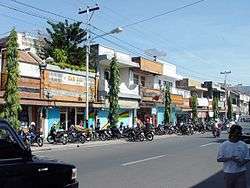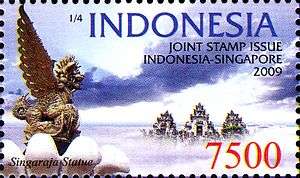Singaraja
Singaraja is a port town in northern Bali, Indonesia, which serves as the seat of Buleleng Regency. The name is Indonesian for "Lion King" (from Sanskrit singha and raja). It is just east of Lovina, with an area of 27.98 km² and population of 80,500, the second largest on the island.

Singaraja | |
|---|---|
 Singaraja statue on the stamp of Indonesia | |
 Singaraja Location in Bali | |
| Coordinates: 8°07′S 115°05′E | |
| Country | Indonesia |
| Province | Bali |
| Population (2005) | |
| • Total | 80,500 |
| Time zone | UTC+8 (Central Indonesia Standard Time) |
Singaraja was the Dutch colonial capital for Bali and the Lesser Sunda Islands from 1849 until 1953, an administrative centre and the port of arrival for most visitors until development of the Bukit Peninsula area in the south. Singaraja was also an administrative centre for the Japanese during their World War II occupation.
Gedong Kirtya, just south of the town centre, is the only library of lontar manuscripts (ancient and sacred texts on leaves of the rontal palm) in the world.
Notable people
- Jero Wacik, politician
- Pandji Tisna, writer, king Buleleng
- Putu Oka Sukanta, writer
Sister cities
Singaraja has the following sister cities:[1]
References
- "City to forge ties with South Korea, Indonesia". Sun.Star Bacolod. 2008-09-27. Archived from the original on 2008-10-01. Retrieved 2008-09-28.
External links

| Wikimedia Commons has media related to Singaraja. |